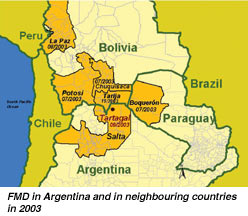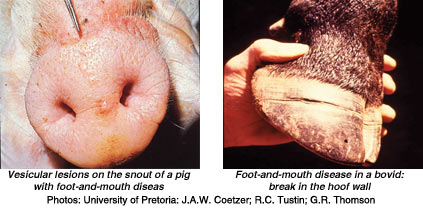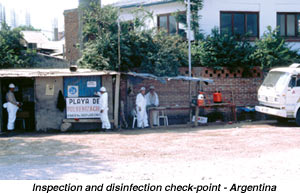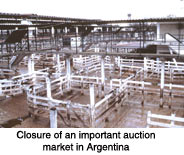


Latin America was affected by several outbreaks of foot-and-mouth disease (FMD) in 2002-2003. Following previous outbreaks in Paraguay (July 2003) and Bolivia (July-August 2003), an outbreak of FMD occurred in Tartagal, province of Salta (northern Argentina, near the border with Paraguay) in September 2003.
 Argentina, the second largest country in South America after Brazil, is situated in southern South America and shares borders with Bolivia and Paraguay to the north, Brazil and Uruguay to the east and Chile to the west. The country covers an area of 2766890km2 with a human population of 38 740 807.
Argentina, the second largest country in South America after Brazil, is situated in southern South America and shares borders with Bolivia and Paraguay to the north, Brazil and Uruguay to the east and Chile to the west. The country covers an area of 2766890km2 with a human population of 38 740 807.
Argentina is the world's fifth largest producer of cattle, yet its exports of live cattle are small because of the presence of FMD in the country and quotas imposed by importing countries. Argentina produces 5 percent of the world's bovine meat (beef and buffalo) at almost 3 million tonnes. This make it the world's fourth largest producer of beef and veal and the tenth largest exporter of fresh bovine meat. In 2000, the United States of America was Argentina's principal market for beef, followed by Germany, Chile, Canada and Israel. Until July 2003, Argentina also exported 9 000 tonnes of beef to Brazil, valued at US$13 million and it sent 19 000 tonnes of beef to Chile worth US$30 million.
Livestock are mainly concentrated in the provinces of Buenos Aires, Santa Fé, Córdoba, Ente Ríos, Corrientes and La Pampa. The province of Salta is characterized by a low livestock density, mainly with subsistence producers. Beef production in Argentina is divided into different zones or areas according to the main purpose for which cattle are bred, determined by geographic, ecological and weather conditions of each area.
TABLE 1 : Livestock production and trade for Argentina |
||||
Animal population |
1999 |
2000 |
2001 |
2002 |
Cattle stocks (head) |
49 056 700 |
48 674 400 |
48 851 400 |
50 669 000 |
Sheep stocks (head) |
13 703 400 |
13 561 600 |
13 500 000 |
4 250 000 |
Goat stocks (head) |
3 402 700 |
3 490 200 |
3 386 600 |
3 550 000 |
Pig stocks (head) |
4 200 000 |
4 200 000 |
4 200 000 |
4 250 000 |
Cattle exports (head) |
10 222 |
21 041 |
14 021 |
79 |
Bovine meat exports (tonnes) |
298 961 |
301 837 |
133 996 |
- |
Source: FAOSTAT. |
||||
TABLE 2: Recent foot-and-mouth disease outbreaks in Argentina and neighbouring countries reported to the OIE |
|||
Country |
Date of outbreak |
Place |
Serotype |
Argentina |
September 2003 |
Tartagal, province of Salta |
O |
Bolivia |
September 2003 |
San Antonio, Chuquisaca department |
O |
August 2003 |
La Paz department |
O | |
July 2003 |
Chuquisaca department, Hernando Siles province |
O |
|
Paraguay |
July 2003 |
Pozo Hondo, Pedro P. Pena district, Boquerón department (3 km from the border with Argentina and 7 km from the border with Bolivia) |
O and A |
October 2002 |
Canindey province (which borders Brazil) |
O |
|
Venezuela |
October 2002 |
Presidente Paez Parish, Alberto Adriani municipality, Merida state |
A |
Normally, animals sent to slaughter, whether for domestic consumption or for export, consist of steers fattened under extensive conditions with natural or planted pastures in fattening areas. Steers of six to seven months of age are weaned and between the ages of seven months to one year are transported by hoof or truck to fattening areas. This system implies the movement of 12 million animals each season.
Sheep production is mainly carried out in the FMD-free Patagonia region (south of the Rio Colorado), which has over 66 percent of the national sheep stock.
Industrial pig production in the country is characterized by full-cycle, closed integrated systems that start the process with piglet breeding and fattening for subsequent slaughter, conducted in facilities often owned by the same firm or in establishments with which agreements have been made. Pigs raised in these types of operations are kept in confinement until the time of slaughter (“all-in-all-out processing”). Since these are closed production systems, there is no contact between pigs and other animal species.
While serotype A has been identified in Venezuela, Bolivia and Argentina were affected by serotype O and Paraguay by both serotypes O and A. Serotype C has not been recorded since 1995 (in Brazil). No Asia 1 or any of the SAT viruses have ever occurred in the Americas.
In April 2001, a widespread outbreak of FMD serotype A affected Argentina's major cattle concentration region. The number of animals exposed to the disease was 2 289 280. Out of 120 383 animals that were affected by the disease, 118 617 (98.5 percent) were bovine, 1 654 (1.4 percent) were pigs, 106 (0.01 percent) were sheep and six were goats. Argentina lost its status of FMD-free country shortly after it had been attained and a new FMD eradication plan was adopted based on the strategy of mass vaccination of the cattle population (a total of 122 million bivalent vaccines using serotypes O and A doses of oil adjuvant vaccine were distributed).
Since 2002, Argentina, which has not had an outbreak of FMD since January 2002 (Vicuña Mackenna, Córdoba province), resumed the export of fresh beef to 62 foreign markets. In the first seven months of 2003, Argentina's beef exports totalled US$322 million. According to government statistics, this was 26 percent more than during the same period in 2001, when many international markets were still closed to Argentine exports.
| FMD affected Tartagal in September 2003 |
FMD was first recorded in Argentina in 1864. Over the past decade, the country has had three major phases of FMD outbreaks. The first phase was from 1990 to 1994, the second from 2000 to January 2002 and the third in 2003. From 1990 to 1994 FMD types A, O and C strains were isolated. From July 2000 to December 2000 types A and O were isolated; from December 2000 to January 2002 exclusively type A, and in September 2003 serotype O was identified.
FMD affected Tartagal, province of Salta (northern Argentina, near the border with Bolivia), in September 2003 (see map).
Table 3 shows the surveillance area, producers and susceptible animals per department in Argentina.
TABLE 3: Surveillance area, estimated number of producers and susceptible animals in Argentina in the provinces of Salta, Formosa and Chaco |
|||||||
Provinces |
Department |
Surface |
Estimated |
No. of |
No. of |
No. of |
Total |
Salta |
Santa |
3 912 |
1 044 |
16 155 |
1 575 |
142 188 |
159 918 |
Victoria |
|||||||
Iruya |
3 515 |
154 |
3 314 |
1 532 |
2 538 |
7 384 | |
Oran |
11 892 |
511 |
21 362 |
2 221 |
6 154 |
29 737 | |
Rivadavia |
4 280 |
889 |
25 432 |
15 150 |
25 722 |
66 304 | |
(South) |
|||||||
Formosa |
Patino |
24 502 |
2 377 |
421 763 |
21 143 |
64 453 |
507 359 |
Chaco |
Almirante |
17 272 |
765 |
126 583 |
3 243 |
35 730 |
165 556 |
TOTAL |
65 373 |
5 740 |
614 609 |
44 864 |
276 785 |
936 258 | |
Source: Servicio Nacional de Sanidad y Calidad Agroalimentaria (SENASA). | |||||||

 In September 2003, the total number of susceptible animals in the outbreak was 58 pigs, ten goats, two sheep and three bovines. Of the 58 pigs, 18 were affected and two cases of deaths were reported. FMD virus type O was detected from swine samples.
In September 2003, the total number of susceptible animals in the outbreak was 58 pigs, ten goats, two sheep and three bovines. Of the 58 pigs, 18 were affected and two cases of deaths were reported. FMD virus type O was detected from swine samples.
The presence of virus serotype O was deduced from the serological response and detected by the liquid phase blocking ELISA (LPB-ELISA), although viral activity was also determined by the 3ABC ELISA and confirmed by Western blotting (WB). Control measures were immediately taken by SENASA (Servicio Nacional de Sanidad y Calidad Agroalimentaria), Argentina, in order to avoid the spread of the disease.
 In addition to immediate implementation of disease control measures in the area affected (by focal, perifocal and surveillance), zoning was initially established as a strategy to mitigate sanitary risk of FMD extension involving the departments of San Martin, Santa Victoria, Orán, Iruya and Rivadavia and the department of Ramón Lista in the province of Formosa.
In addition to immediate implementation of disease control measures in the area affected (by focal, perifocal and surveillance), zoning was initially established as a strategy to mitigate sanitary risk of FMD extension involving the departments of San Martin, Santa Victoria, Orán, Iruya and Rivadavia and the department of Ramón Lista in the province of Formosa.
The zoning areas were subsequently enlarged and at this time they involved an area comprised of the Bermejo River to the north at the international border with Bolivia and Paraguay, including the department of Gral, José de San Martín and northern Rivadavia in the province of Salta and the departments of Ramón Lista, Matacos and Bermejo in the province of Formosa. The implementation of intensive strategic sanitary measures was established in this zone. Outside this area, surveillance area actions were established, comprising the bordering departments of the provinces of Salta and Formosa.
TABLE 4: Specific measures of the sanitary emergency |
|
Area affected | •Movement of the Emergency Team to the zone. The team consists of SENASA staff from the Epidemiology, Laboratory and Technical Control Bureaus. They are in the zone to coordinate and develop sanitary actions with regard to suspected FMD. • Focal area: prohibition of all movements of incoming and outgoing susceptible species from the establishments, including people and potentially contaminated objects (fomites), which may act as carriers of the aetiological agent. Sample collection, sacrifice and incineration of affected animals and contacts, disinfection and biosecurity measures were also conducted. • Perifocal area: a distance of 3 km from the focal area where vaccination of all susceptible animals, control of animal movements, identification, tracing and serological sampling were carried out. • Surveillance area: 10 km from the perifocal area. In this area, vaccination of all susceptible species, control of movement, tracing and serological sampling with identification were carried out. Also instituted were: • the closure of the Tartagal municipal slaughterhouse; • the establishment of four disinfection and movement control posts. |
Additional intensive strategic actions |
Measures • Temporary prohibition of movement of FMD-susceptible animals, to any destination and for any purpose, with the exception of immediate local slaughter. • Prohibition of incoming FMD susceptible animals, except those intended for immediate slaughter. • Disallowing entry into the area of animals destined for slaughter. • Closure of slaughterhouses with no national or provincial approval or with inadequate biosecurity measures. Actions • Registration of all farms and producers within the area. • Strategic vaccination against FMD and identification by ear tags of all susceptible animals. • Revaccination after 30 days. • Establishment of disinfection and movement control posts, with personnel from SENASA and the support of the security forces (border police, police, etc.). • Public awareness bulletin for local media with the aim of informing people about sanitary actions to be carried out within the zone. • Intensification of border controls at crossings and conducting border patrols with national border police assistance. |
Surveillance area actions (surveillance zone) |
• Registration of all farms and producers in the area housing susceptible animals. • Systematic FMD vaccination of bovines. • Prohibition of animal movement unless destined for slaughter, outside the surveillance zone conducted under official control. • Epidemiological surveillance (disease search, serological screening). |
Brazil, Chile, Paraguay and Uruguay temporarily banned imports of Argentine meat products to prevent the spread of a new FMD outbreak.
The agriculture ministers of Argentina, Bolivia, Brazil, Chile, Paraguay, Peru and Uruguay held a meeting in July 2003 in Bolivia to increase cooperation in controlling FMD in the region and signed an agreement on emergency and contingency plans.
To date there are no new outbreaks of FMD reported in Argentina and the last active outbreak was contained |
The province of Salta is characterized by a low livestock density, mainly with subsistence producers, with no production link with other regions.
To date there are no new outbreaks of FMD reported in Argentina and the last active outbreak was contained. All the FMD outbreaks in Bolivia, including the outbreak in Morros Blancos, Tarija department, have been controlled. In Paraguay, stamping out of all susceptible animals in the outbreak was completed by 15 July 2003.
In comparison with the events of 2001, where the producers' concern was made public, measures were undertaken late because of the lack of communication within Argentina and the subsequent spread of FMD to Uruguay and Brazil. By contrast, in 2003, coordinated action inside the country and an exchange of information among neighbours were indispensable to control disease in the region. The difference between FMD outbreak outcomes between the type A Argentine epidemic of 2001 and the most recent one caused by serotype O in 2003 is attributed to early detection and early response.

Cané, B.G. 2001. Foot-and-mouth disease in Argentina: the experience of eradication and the crisis as an opportunity to produce a sustainable change in the cattle industry. (International Conference on Prevention and Control of Foot-and-Mouth Disease, Brussels, 12-13 December 2001.)
Foot-and-mouth disease, Argentina. 16 March 2001, Impact Worksheet (available at USDA Web site: http://www.aphis.usda.gov/vs/ceah/cei/fmd_argentina0301e.htm/).
International Office of Epizootics (OIE).
Servicio Nacional de Sanidad y Calidad Agroalimentaria (SENASA). 2003. Report of sanitary actions in view of the presence of a foot-and-mouth disease outbreak in Tartagal, province of Salta, Argentina.
Sutmoller, P. & Casas Olascoaga, R. 2002. The successful control and eradication of foot-and-mouth disease epidemics in South America in 2001.
Xinhua News Agency, Buenos Aires, Argentina.
Organized by the Food and Agriculture Organization of the United Nations (FAO) in collaboration with the Egyptian Veterinary Medical Association (EVMA) and attended by representatives from Egypt, Kuwait, Saudi Arabia, the Sudan, the Syrian Arab Republic, Tunisia and Turkey and representatives from FAO, the European Commission for the Control of Foot-and-Mouth Disease (EUFMD), OIE and the Arab Organization for Agricultural Development (AOAD)
These recommendations were submitted by Dr Talib Ali Elam at the high-level technical workshop “Regional Programmes for Food Security in the Near East: Towards Sustainable Food Security and Poverty Alleviation” held in Jeddah, Saudi Arabia, from 8 to 9 October 2003. The workshop was organized by the Islamic Development Bank (IDB) and FAO and was attended by representatives from Saudi Arabia, the Arab Maghreb Union (AMU), the Arab Organization for Agricultural Development (AOAD), the Arab Authority for Agricultural Investment and Development (AAAID), the Community of Sahel and Saharan States (CEN-SAD), the Intergovernmental Authority on Development (IGAD), the Economic Cooperation Organization (ECO), the African Development Bank (ADB) and the OPEC Fund for Development.